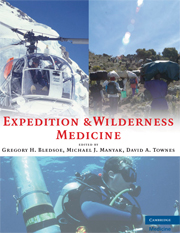Book contents
- Frontmatter
- Contents
- Contributors
- Foreword
- Preface
- Acknowledgments
- PART I EXPEDITION PLANNING
- PART II EXPEDITIONS IN UNIQUE ENVIRONMENTS
- 13 Tactical and Protective Medicine
- 14 Hostile Geopolitical Environments
- 15 Aerospace Medicine
- 16 Polar Medicine
- 17 Tropical Medicine for Expeditions
- 18 Subterranean Medicine
- 19 High-Altitude Medicine
- 20 Medicine at Sea
- 21 Event Medicine
- 22 Telemedicine in Evolution: Implications for Expeditionary Medicine
- 23 Dive Medicine
- PART III ILLNESS AND INJURIES ON EXPEDITIONS
- APPENDIX The Expedition Medical Kit
- Index
16 - Polar Medicine
from PART II - EXPEDITIONS IN UNIQUE ENVIRONMENTS
Published online by Cambridge University Press: 05 March 2013
- Frontmatter
- Contents
- Contributors
- Foreword
- Preface
- Acknowledgments
- PART I EXPEDITION PLANNING
- PART II EXPEDITIONS IN UNIQUE ENVIRONMENTS
- 13 Tactical and Protective Medicine
- 14 Hostile Geopolitical Environments
- 15 Aerospace Medicine
- 16 Polar Medicine
- 17 Tropical Medicine for Expeditions
- 18 Subterranean Medicine
- 19 High-Altitude Medicine
- 20 Medicine at Sea
- 21 Event Medicine
- 22 Telemedicine in Evolution: Implications for Expeditionary Medicine
- 23 Dive Medicine
- PART III ILLNESS AND INJURIES ON EXPEDITIONS
- APPENDIX The Expedition Medical Kit
- Index
Summary
The polar environment is hostile, dangerous and unfamiliar; cold, isolation, photoperiodicity, katabatic winds, and whiteout combine with the polar ice caps, crevassed glaciers, and ever-changing sea ice. Expedition medical practice in such regions is extreme, as all groups have had to travel great distances, are self-sustaining in that all medical supplies, equipment, and expertise must be available on the expedition, and complex logistics are required. Evacuation, if possible, is expensive, requires great effort, and can be dangerous.
Although Iceland and Greenland were discovered centuries before, it was not until the late 1500s that Davis, Frobisher, and Barents led expeditions to the Canadian Arctic, Greenland, and Spitsbergen. These were the stimuli for the many expeditions that followed. Magellan's discovery in 1520 of the straits that now bear his name and Cook's crossing of the Antarctic Circle in 1773 had a similar effect on the Antarctic. Initially, the motivation was exploration and discovery, but with time this changed to exploitation and science. The advent of commercial tourism and adventure travel over the past 50 years has seen a plethora of expeditions in the polar regions, bringing many more people of all ages and physical status. Such expeditions have been a catalyst for dramatic changes to medical support. Polar regions technology has made improvements in clothing, equipment, food, and shelter, but the environment is no less challenging than it was to the early explorers.
What are the polar regions? There are a number of definitions.
- Type
- Chapter
- Information
- Expedition and Wilderness Medicine , pp. 197 - 205Publisher: Cambridge University PressPrint publication year: 2008

